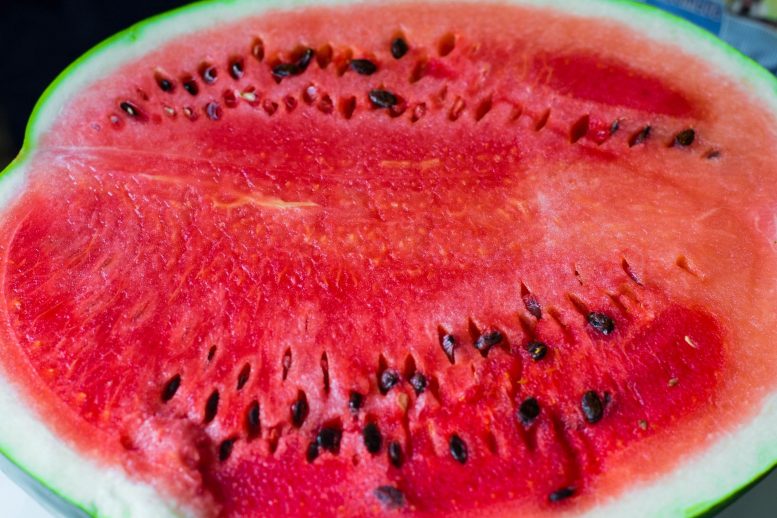
Posted on 05/28/2021 9:19:12 AM PDT by Red Badger

Just in time for picnic-table trivia, a new study published in the Proceedings of the National Academy of Sciences rewrites the origins of domesticated watermelons.
Using DNA from greenhouse-grown plants representing all species and hundreds of varieties of watermelon, scientists discovered that watermelons most likely came from wild crop progenitors in northeast Africa.
The study corrects a 90-year-old mistake that lumped watermelons into the same category as the South African citron melon. Instead, researchers, including a first author now at Washington University in St. Louis, found that a Sudanese form with non-bitter whitish pulp, known as the Kordofan melon (C. lanatus), is the closest relative of domesticated watermelons.
The genetic research is consistent with newly interpreted Egyptian tomb paintings that suggest the watermelon may have been consumed in the Nile Valley as a dessert more than 4,000 years ago.
“Based on DNA, we found that watermelons as we know them today — with sweet, often red pulp that can be eaten raw — were genetically closest to wild forms from west Africa and northeast Africa,” said Susanne S. Renner, honorary professor of biology in Arts & Sciences at Washington University.
Renner is an evolutionary biologist who recently joined Washington University after 17 years working as a professor at Ludwig Maximilian University in Munich, Germany, where she also served as the director of the Munich Botanical Garden and Munich herbarium.
Her lab has long focused on honey melons and cucumbers, but for the past 10 years she has turned to watermelons and bitter gourds.
The genetic information published in the new study — completed with colleagues from the U.S. Department of Agriculture in Ithaca, New York; the Royal Botanic Gardens, Kew in London; and the University of Sheffield — could be useful for developing a more disease-resistant watermelon crop, Renner said.
“Today’s watermelon comes from a very small genetic stock and is highly susceptible to diseases and insect pests, including various mildews, other fungi, viruses, and nematodes [worms],” Renner said. “So far, we found variation in three disease resistance genes between the Kordofan melon and the domesticated watermelon. Breeders might use these and other insights from the genome.”
But some of the greatest takeaways from this study, Renner said, are related to the mobility of people and their cultural connections.
“It was the Egyptian tomb paintings that convinced me that the Egyptians were eating cold watermelon pulp,” Renner said. “Otherwise, why place those huge fruits on flat trays next to grapes and other sweet fruits?”
“Melons, cucumbers, and watermelons were domesticated several times” across human history, she said. “But to place these domestications in space and name is much more difficult than I thought 10 to 15 years ago. DNA from ancient seeds is already beginning to help.”
Reference: “A chromosome-level genome of a Kordofan melon illuminates the origin of domesticated watermelons” by Susanne S. Renner, Shan Wu, Oscar A. Pérez-Escobar, Martina V. Silber, Zhangjun Fei and Guillaume Chomicki, 24 May 2021, Proceedings of the National Academy of Sciences. DOI: 10.1073/pnas.2101486118
I helped start National Semiconductor in Santa Clara in 1967, ended up retiring from Texas Instruments at the end of 1994. All chip-making.
Yup. My mom always did that.
Yep! I’ve gotten some funny looks in restaurants!..................
Hmmm. I don't live far from the Catalina restaurant presently. My parents always went there. I've not been there in years...
It's still open?
Thanks Red Badger.
As a young man, during the 40’s & 50’s, I was always attracted by melons...
Although, a few times, that led to getting my face slapped...
You're correct., it has that quality.
I went to the Getty Museum and saw Van Gogh's painting Irisis two feet in front of me.
In fact, I was told, "please stand back sir."
That thing was valued at $54 million. It was just in a frame on the wall.
(My son lives near there)
Don’t squeeze the melons!................
Paul Harvey had a caller once that told him he was thrilled the Paul Harvey show was coming to the Timonium Fair Grounds in september. Loving the man, he wanted to know if he should buy tickets early. the woman asked for what venue and he said the paul harvey show in september and she said the only venue in september was the Fall RV Show. He was disappointed to say the least. And now you know, the rest of the story.
LOL!..................

Hey, it’s SCIENCE!..................
They have opened a small restaurant in Bayou La Batre. Some of my family went down there recently and said it was the same Catalina food we grew up on. My father was the manager of the one on Azalea Rd. for years and was bookkeeper for all of them except the main one in Coden.
Great post!
Yikes mister. You must be up in your 90’s. Glad you’re still on this side of the veil and showing some wit.
I had thought since I was a child that water melons were members of the squash family.
But my gardening as and adult and my absolute luv of lemon cucumbers proved to me that watermelons are more closely related to curcurbit sativa!
I don’t get it. I’ve known that for at least sixty years.
Disclaimer: Opinions posted on Free Republic are those of the individual posters and do not necessarily represent the opinion of Free Republic or its management. All materials posted herein are protected by copyright law and the exemption for fair use of copyrighted works.